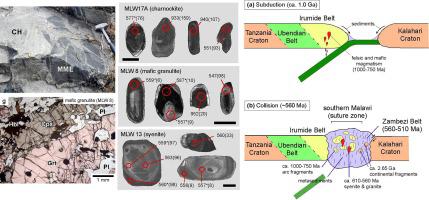当前位置:
X-MOL 学术
›
Precambrian. Res.
›
论文详情
Our official English website, www.x-mol.net, welcomes your feedback! (Note: you will need to create a separate account there.)
Neoproterozoic crustal growth in Southern Malawi: New insights from petrology, geochemistry, and U–Pb zircon geochronology, and implications for the Kalahari Craton–Congo Craton amalgamation
Precambrian Research ( IF 3.8 ) Pub Date : 2021-01-01 , DOI: 10.1016/j.precamres.2020.106007 Toshiaki Tsunogae , Sam Uthup , Mzee Wandembo Nyirongo , Kazuki Takahashi , Md. Sazzadur Rahman , Qian Liu , Yusuke Takamura , Yukiyasu Tsutsumi
Precambrian Research ( IF 3.8 ) Pub Date : 2021-01-01 , DOI: 10.1016/j.precamres.2020.106007 Toshiaki Tsunogae , Sam Uthup , Mzee Wandembo Nyirongo , Kazuki Takahashi , Md. Sazzadur Rahman , Qian Liu , Yusuke Takamura , Yukiyasu Tsutsumi

|
Abstract The southern part of the Malawi Basement Complex is regarded as being part of the Mozambique Belt, which was formed by a series of collisions between Archean cratons and/or Proterozoic magmatic arcs during Neoproterozoic to Cambrian time. The region is particularly important because of its location near the junction between the East-African (ca. 600–550 Ma) and Kuunga (ca. 560–530 Ma) orogens, which means that complex magmatic or metamorphic episodes may have been recorded in high-grade metamorphic rocks in the region. Here we report on new petrological, geochemical, and zircon U–Pb age data on felsic to mafic orthogneisses as well as on a syn-tectonic syenite from the Lilongwe–Zomba–Blantyre area in southern Malawi, with a view to evaluating the timing and pressure–temperature (P–T) conditions of the collision events as well as the protolith formation. The geochemical data on the felsic orthogneisses suggested magmatic-arc signatures, whereas the mafic orthogneisses had both magmatic-arc and non-arc signatures. Metamorphic P–T estimates for the orthogneisses based on conventional geothermometry and phase-equilibria modeling indicated high-pressure granulite-facies conditions of 9.1–11.6 kbar and 840 °C–930 °C. Zircons obtained from charnockite, biotite gneiss, and garnet-bearing mafic granulite yielded magmatic ages of 1011–808 Ma, 1013 Ma, and 1076 Ma, respectively, suggesting the presence of Stenian–Tonian crustal growth related to arc magmatism. Ediacaran (573 Ma) intrusion of granitic rock was also inferred from magmatic zircons found within a granitoid gneiss. The timing of the high-grade metamorphism was constrained by the ages of the zircon rims and found to be 569–557 Ma, thus coinciding with the intrusion of syn-tectonic syenite at 562 Ma. The results of this study suggest that the southern part of Malawi is composed of remnants of the Stenian–Tonian magmatic arc, which were metamorphosed together with surrounding metasediments around 560 Ma. The Ediacaran high-grade metamorphism is consistent with the age of the Zambezi Belt located immediately southwest of the Malawi Basement Complex. Both the Lilongwe–Zomba–Blantyre area and the Zambezi Belt may correspond to a single suture zone formed by the latest Neoproterozoic collision between the Kalahari and Congo Cratons.
中文翻译:

马拉维南部新元古代地壳生长:来自岩石学、地球化学和 U-Pb 锆石年代学的新见解,以及对卡拉哈里克拉通-刚果克拉通合并的影响
摘要 马拉维基底杂岩体南部被认为是莫桑比克带的一部分,是由新元古代至寒武纪太古宙克拉通和/或元古代岩浆弧发生一系列碰撞而形成的。该地区特别重要,因为它靠近东非(约 600-550 Ma)和 Kuunga(约 560-530 Ma)造山带之间的交界处,这意味着复杂的岩浆或变质事件可能已被记录在该地区的高品位变质岩。在这里,我们报告了新的岩石学、地球化学和锆石 U-Pb 年龄数据,这些数据来自马拉维南部的 Lilongwe-Zomba-Blantyre 地区的长英质至镁铁质正方麻岩以及同构造正长岩,以评估碰撞事件以及原岩形成的时间和压力-温度(P-T)条件。长英质正片麻岩的地球化学数据表明具有岩浆弧特征,而镁铁质正片麻岩具有岩浆弧特征和非弧特征。基于常规地温测量和相平衡模型的正方麻岩变质 P-T 估计表明高压麻粒岩相条件为 9.1-11.6 kbar 和 840°C-930°C。从charnockite、黑云母片麻岩和含石榴石的镁铁质麻粒岩中获得的锆石分别产生了1011-808 Ma、1013 Ma和1076 Ma的岩浆年龄,表明存在与弧形岩浆作用相关的Stenian-Tonian地壳生长。从花岗岩片麻岩中发现的岩浆锆石也推断出埃迪卡拉纪 (573 Ma) 侵入花岗岩。高品位变质作用时间受锆石边缘年龄限制,发现时间为569-557 Ma,与562 Ma同构造正长岩侵入相吻合。这项研究的结果表明,马拉维南部由 Stenian-Tonian 岩浆弧的残余物组成,这些残余物在 560 Ma 左右与周围的变质沉积物一起变质。埃迪卡拉纪的高等级变质作用与位于马拉维基底复合体西南方向的赞比西河带的年龄一致。Lilongwe-Zomba-Blantyre 地区和赞比西河带可能对应于由最近的新元古代喀拉哈里克拉通与刚果克拉通碰撞形成的单一缝合带。高品位变质作用时间受锆石边缘年龄限制,发现时间为569-557 Ma,与562 Ma同构造正长岩侵入相吻合。这项研究的结果表明,马拉维南部由 Stenian-Tonian 岩浆弧的残余物组成,这些残余物在 560 Ma 左右与周围的变质沉积物一起变质。埃迪卡拉纪的高等级变质作用与位于马拉维基底复合体西南方向的赞比西河带的年龄一致。Lilongwe-Zomba-Blantyre 地区和赞比西河带可能对应于由最近的新元古代喀拉哈里克拉通与刚果克拉通碰撞形成的单一缝合带。高品位变质作用的时间受锆石边缘年龄的限制,发现为569-557 Ma,与562 Ma同构造正长岩的侵入相吻合。这项研究的结果表明,马拉维南部由 Stenian-Tonian 岩浆弧的残余物组成,这些残余物在 560 Ma 左右与周围的变质沉积物一起变质。埃迪卡拉纪的高等级变质作用与位于马拉维基底复合体西南方向的赞比西河带的年龄一致。Lilongwe-Zomba-Blantyre 地区和赞比西河带可能对应于由最近的新元古代喀拉哈里克拉通与刚果克拉通碰撞形成的单一缝合带。因此与 562 Ma 同构造正长岩的侵入相吻合。这项研究的结果表明,马拉维南部由 Stenian-Tonian 岩浆弧的残余物组成,这些残余物在 560 Ma 左右与周围的变质沉积物一起变质。埃迪卡拉纪的高等级变质作用与位于马拉维基底复合体西南方向的赞比西河带的年龄一致。Lilongwe-Zomba-Blantyre 地区和赞比西河带可能对应于由最近的新元古代喀拉哈里克拉通与刚果克拉通碰撞形成的单一缝合带。因此与 562 Ma 同构造正长岩的侵入相吻合。这项研究的结果表明,马拉维南部由 Stenian-Tonian 岩浆弧的残余物组成,这些残余物在 560 Ma 左右与周围的变质沉积物一起变质。埃迪卡拉纪的高等级变质作用与位于马拉维基底复合体西南方向的赞比西河带的年龄一致。Lilongwe-Zomba-Blantyre 地区和赞比西河带可能对应于由最近的新元古代喀拉哈里克拉通与刚果克拉通碰撞形成的单一缝合带。埃迪卡拉纪的高等级变质作用与位于马拉维基底复合体西南方向的赞比西河带的年龄一致。Lilongwe-Zomba-Blantyre 地区和赞比西河带可能对应于由最近的新元古代喀拉哈里克拉通与刚果克拉通碰撞形成的单一缝合带。埃迪卡拉纪的高等级变质作用与位于马拉维基底复合体西南方向的赞比西河带的年龄一致。Lilongwe-Zomba-Blantyre 地区和赞比西河带可能对应于由最近的新元古代喀拉哈里克拉通与刚果克拉通碰撞形成的单一缝合带。
更新日期:2021-01-01
中文翻译:

马拉维南部新元古代地壳生长:来自岩石学、地球化学和 U-Pb 锆石年代学的新见解,以及对卡拉哈里克拉通-刚果克拉通合并的影响
摘要 马拉维基底杂岩体南部被认为是莫桑比克带的一部分,是由新元古代至寒武纪太古宙克拉通和/或元古代岩浆弧发生一系列碰撞而形成的。该地区特别重要,因为它靠近东非(约 600-550 Ma)和 Kuunga(约 560-530 Ma)造山带之间的交界处,这意味着复杂的岩浆或变质事件可能已被记录在该地区的高品位变质岩。在这里,我们报告了新的岩石学、地球化学和锆石 U-Pb 年龄数据,这些数据来自马拉维南部的 Lilongwe-Zomba-Blantyre 地区的长英质至镁铁质正方麻岩以及同构造正长岩,以评估碰撞事件以及原岩形成的时间和压力-温度(P-T)条件。长英质正片麻岩的地球化学数据表明具有岩浆弧特征,而镁铁质正片麻岩具有岩浆弧特征和非弧特征。基于常规地温测量和相平衡模型的正方麻岩变质 P-T 估计表明高压麻粒岩相条件为 9.1-11.6 kbar 和 840°C-930°C。从charnockite、黑云母片麻岩和含石榴石的镁铁质麻粒岩中获得的锆石分别产生了1011-808 Ma、1013 Ma和1076 Ma的岩浆年龄,表明存在与弧形岩浆作用相关的Stenian-Tonian地壳生长。从花岗岩片麻岩中发现的岩浆锆石也推断出埃迪卡拉纪 (573 Ma) 侵入花岗岩。高品位变质作用时间受锆石边缘年龄限制,发现时间为569-557 Ma,与562 Ma同构造正长岩侵入相吻合。这项研究的结果表明,马拉维南部由 Stenian-Tonian 岩浆弧的残余物组成,这些残余物在 560 Ma 左右与周围的变质沉积物一起变质。埃迪卡拉纪的高等级变质作用与位于马拉维基底复合体西南方向的赞比西河带的年龄一致。Lilongwe-Zomba-Blantyre 地区和赞比西河带可能对应于由最近的新元古代喀拉哈里克拉通与刚果克拉通碰撞形成的单一缝合带。高品位变质作用时间受锆石边缘年龄限制,发现时间为569-557 Ma,与562 Ma同构造正长岩侵入相吻合。这项研究的结果表明,马拉维南部由 Stenian-Tonian 岩浆弧的残余物组成,这些残余物在 560 Ma 左右与周围的变质沉积物一起变质。埃迪卡拉纪的高等级变质作用与位于马拉维基底复合体西南方向的赞比西河带的年龄一致。Lilongwe-Zomba-Blantyre 地区和赞比西河带可能对应于由最近的新元古代喀拉哈里克拉通与刚果克拉通碰撞形成的单一缝合带。高品位变质作用的时间受锆石边缘年龄的限制,发现为569-557 Ma,与562 Ma同构造正长岩的侵入相吻合。这项研究的结果表明,马拉维南部由 Stenian-Tonian 岩浆弧的残余物组成,这些残余物在 560 Ma 左右与周围的变质沉积物一起变质。埃迪卡拉纪的高等级变质作用与位于马拉维基底复合体西南方向的赞比西河带的年龄一致。Lilongwe-Zomba-Blantyre 地区和赞比西河带可能对应于由最近的新元古代喀拉哈里克拉通与刚果克拉通碰撞形成的单一缝合带。因此与 562 Ma 同构造正长岩的侵入相吻合。这项研究的结果表明,马拉维南部由 Stenian-Tonian 岩浆弧的残余物组成,这些残余物在 560 Ma 左右与周围的变质沉积物一起变质。埃迪卡拉纪的高等级变质作用与位于马拉维基底复合体西南方向的赞比西河带的年龄一致。Lilongwe-Zomba-Blantyre 地区和赞比西河带可能对应于由最近的新元古代喀拉哈里克拉通与刚果克拉通碰撞形成的单一缝合带。因此与 562 Ma 同构造正长岩的侵入相吻合。这项研究的结果表明,马拉维南部由 Stenian-Tonian 岩浆弧的残余物组成,这些残余物在 560 Ma 左右与周围的变质沉积物一起变质。埃迪卡拉纪的高等级变质作用与位于马拉维基底复合体西南方向的赞比西河带的年龄一致。Lilongwe-Zomba-Blantyre 地区和赞比西河带可能对应于由最近的新元古代喀拉哈里克拉通与刚果克拉通碰撞形成的单一缝合带。埃迪卡拉纪的高等级变质作用与位于马拉维基底复合体西南方向的赞比西河带的年龄一致。Lilongwe-Zomba-Blantyre 地区和赞比西河带可能对应于由最近的新元古代喀拉哈里克拉通与刚果克拉通碰撞形成的单一缝合带。埃迪卡拉纪的高等级变质作用与位于马拉维基底复合体西南方向的赞比西河带的年龄一致。Lilongwe-Zomba-Blantyre 地区和赞比西河带可能对应于由最近的新元古代喀拉哈里克拉通与刚果克拉通碰撞形成的单一缝合带。


























 京公网安备 11010802027423号
京公网安备 11010802027423号